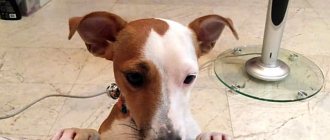Toy Terriers are incredibly smart and loyal dogs.
They will fit perfectly into any family, but, like other breeds, they require special care.
They are small, but not toys at all. Each representative of the Toy Terrier breed has its own character and characteristics.
This must be taken into account if you decide to get just such a dog.
When do your ears stand up?
Toys are born with drooping ears because the cartilage that forms this organ is still very weak and tender. With age , the auricle should become stronger and acquire a standing position.
What time should a toy's ears stand up? Toy terriers do not have a specific age at which this should happen - the process of natural formation of strong cartilage in a puppy takes about six months, starting from birth. If your pet is already at this age, and his ears are still not erect, then this is a reason to sound the alarm.
Many dogs already have erect ears at 2-3 months, and in some, the auricle forms after four months of age.
NOTE!
In long-haired toy dogs, a reclining ear position is allowed. This is due to the fact that the hair on this organ weighs down the auricle, due to which it cannot rise completely.
Is it necessary to dock?
The ears of a toy terrier be cropped , which cannot be said about many other breeds.
If the ears develop without any pathologies, then they should be large, in a standing position, and set high. Due to the position of the ear, you can always determine whether the dog is purebred or not.
Dog handlers claim that due to precisely this correct position of the ears, balance with the long dog legs is achieved. Such an animal looks proportional and harmonious.
IMPORTANT!
A short-haired toy terrier with floppy ears is not allowed to participate in exhibitions. This is considered a disqualifying factor.
When should you “bet”?
The breed standard clearly states that the ear should be in a standing position and not in any other position. Therefore, if participation in exhibitions is a fundamental factor for you, and ear cartilage is not formed naturally, then it’s time to apply measures from the outside world.
Moreover, a recumbent ear can cause some health problems , primarily with the hearing organ.
But if you do not plan to take Toy to exhibitions at all and agree to carefully monitor the condition of the ears, then you can do without the procedure for supplying the ears.
If a dog appears in the house in order to take prizes, then you need to monitor the condition of its ears:
- watch your puppy from the moment you get him;
- if the puppy is already 6 months old and the ears are lying down, then carry out the procedure for supplying the ears;
- if you see that this process went wrong, then you need to make an adjustment.
Possible causes of problems
The reason why a young toy's ears do not stand up is excessively soft cartilage tissue. But there may be several factors influencing this:
- The slow development of cartilage tissue may be due to heredity. The puppy’s mother may not have received proper nutrition during pregnancy, or there may have been certain pathologies in the dog itself, all of which affected the formation of cartilage tissue in the fetus.
- Incorrect selection of breed representatives for mating also negatively affects the appearance of the offspring.
- The human factor cannot be ruled out. A responsible dog breeder himself monitors the health of the offspring and must correct the ears in a timely manner if the need arises.
- If the Toy puppy is completely purebred, but there are difficulties with the positioning of the ears, then we may be talking about problems with the immune system caused by the stressful state of the baby.
- Deficiencies of vitamins, minerals and calcium can also cause weak ears.
As you can see, the process of setting the ears of toy terriers must be carefully controlled. After all, this is an indicator not only of the pet’s appearance, but also of its health.
Source
Why don't my ears stand up?
For some owners of this breed, it is the ear problem that becomes urgent.
They don't rise for many reasons, but here are the main ones:
- The puppy’s parents had problems with the formation of ear cartilage;
- the baby did not receive sufficient nutrition from the mother in infancy;
- the breeder did not provide the grown puppy with food rich in all the necessary vitamins, i.e. he eats an unbalanced diet;
- the puppy was obtained by mating a long-haired and a short-haired toy terrier;
- calcium deficiency;
- various injuries of the auricle at birth or later;
- stressful situations
NOTE!
If you are afraid that your dog’s ear will not stand up, although you are confident in his health and in the health of his parents, then after consulting with a veterinarian, start giving him vitamin supplements.
Jack Russell Terrier
The Jack Russell Terrier's ears are indicators of the pet's mood. They are very mobile and, despite this, always return to their original position. In this case, the ears should droop or resemble a V-shape. There are situations when the Jack Russell Terrier's ears stand up and do not want to go down. What to do?
The age when an animal’s ears begin to stand up is three or four months. If this happens, try to find out the reason. A common cause is genetic predisposition. This occurs when the puppy’s parents also had erect ears. In this case, nothing can be done, and erect ears will become the highlight of your pet.
What to do if your ears don't stand up?
When a toy terrier puppy's ears do not stand up when he reaches six months of age, this is a serious problem for those who got a dog not only to acquire a cheerful friend, but also for exhibitions. Therefore, this issue needs to be resolved as early as possible, before it is too late.
Sometimes, no matter how hard the animal owner tries, the ears still do not take a standing position, and some incorrectly placed ears can no longer be corrected. This means that the pet’s competitive and exhibition career can be put to rest.
Algorithm of action if you notice that your ears do not stand up:
- First of all, you need to contact a specialist. He will ask you some leading questions. This will make it possible to find out the reason why the puppy has problems in terms of positioning the auricle. We must remember that the sooner you find out the correct cause, the sooner you begin treatment, which means you are more likely to be able to eliminate the pathology;
- The dog will need to undergo a course of treatment prescribed by a doctor. These can be special tonic preparations, as well as vitamin supplements;
- Review your pet's diet and consider: does he receive a sufficient amount of all the elements necessary for growth and development? Be prepared for the fact that some products will have to be removed, some replaced, and something new added;
- Make sure your animal gets calcium. It is sold separately at the vet. pharmacies, but you can prepare, for example, calcined cottage cheese for your pet;
- Together with the above, gluing the ears of a toy terrier has a productive effect. Thus, the ear cartilages will always be in a standing position and strengthened due to all the supplements and vitamins that the dog receives after the start of treatment;
- If, after the gluing procedure is carried out, you see that the ears are not fully erect, then it is worth carrying out this process with individual parts of the auricle, and not with the entire cartilage;
You must keep in mind that even if you follow all the recommendations and carry out all the necessary procedures, your toy terrier’s ears may still not rise. If this happens, all you have to do is accept it. The dog will not lose the best qualities of its character from this factor.
Expert opinion
Kozhevin Semyon Kirillovich
Expert dog handler.
Nowadays this problem is very common, especially when you consider that many new owners take Russian Toy puppies without fully understanding all the features of their maintenance. The main thing is to avoid deviations in ear development at all, but if you already have some suspicions, then don’t hesitate. You can consult with the breeder from whom you took the puppy, or go to the veterinarian - they will give you recommendations. It is not always possible to raise the ears, but the sooner you start treating this and if you care for the puppy correctly from the very beginning, then no problems will arise.
gluing ears
1.
Cut a piece of the patch, approximately 4 centimeters. We recommend carefully cutting out the ends of the patch, rounding them on all sides.
2.
We apply the patch from the inside along the entire ear so that the lower edge of the patch is glued below the fold line of the ear by 0.5-1 centimeter. We press the patch very carefully to the ear, making massaging, rubbing movements when gluing.
3.
We make a tire. To do this, take a plastic card and cut out a strip of about 0.5 cm in width and 3 - 3.5 cm in height. The height of the splint should be less than the length of the strip of plaster that we glued to the inside of the ear. The ends of the plastic strip, which will serve as a splint for us, must be rounded so that they do not rub or injure the delicate skin of the inner surface of the puppy’s ear.
4.
Then we cut out another piece of the patch, slightly smaller in size than the one we pasted as the first layer from the inside of the ear. We cut off the ends of the patch, rounding them on all sides.
5.
We take the prepared splint (plastic strip) and place it on the middle of the piece of plaster we prepared with its adhesive side.
Before gluing a prepared piece of plaster with a splint attached to it onto a piece of plaster previously glued to the ear, it is necessary to take into account that the height of the splint (plastic strip) is placed in such a way that it is 0.5 centimeters below the fold line of the ear, but In no case should it fall below the previously glued patch, otherwise the splint will rub the ear. The width of the stick is located almost in the middle of the ear.
6.
Now we take a piece of the patch with a splint strip attached to it and glue it over the previously glued piece of the patch, taking into account the above recommendations along the entire length of the ear. Just as before, we press the patch very carefully to the ear, making massaging, rubbing movements when gluing.
The standard stipulates that the ears should be large, erect and high-set. If the ears are not set high enough, they will certainly end up floppy and not very stable. When the longhaired variety of Toy Terriers becomes heavy with hair, their ears easily become semi-erect or droopy. Therefore, the most desirable position of the ears is one in which the inner edges of the ears are as close to parallel to each other as possible. At the next stage of gluing the ears, we will strive to obtain exactly the desired position of them, while ensuring that the inner edges of the ears are parallel to each other.
7.
Prepare stationery tape. It is the tape that is very convenient for gluing the ears of long-haired toy terriers, since it does not spoil the decorative fringes on the ears and is easily removed without damaging the hair. For smooth-haired Toys, the tape can be replaced with a medical adhesive plaster.
8.
Take the ear by the tip and pull it up and slightly to the side, towards the puppy's head. Then turn the ear counterclockwise (counterclockwise when gluing the dog’s right ear, clockwise when gluing the left ear), twisting it into a “tube”, while continuing to keep the ear raised and taut.
9.
Now, with a strip of tape, slightly moving away from the base, wrap the ear around 2-3 times.
Repeat the same procedure with the other ear, making sure that the tips of the ears are at the same level.
Don't wrap the tape too tightly. If you did everything correctly, the ears will turn into vertical white horns with a small ear tip at the top. The tip should not hang down, but stick out confidently from under the patch upwards.
If after gluing the “ears-horns” look crooked, it means you made a mistake and need to immediately start over.
If, after some time, the tips begin to fall off, then wrap the ear with tape in the middle, and, if necessary, in the upper part. After 10-15 days, the “horns” can begin to be “lightened.” That is, do not wrap the ear in several places, but only at the base.
The most gentle method
The most acceptable and traditional way of setting up the ears is considered to be gluing.
For this procedure to be successful, you must strictly follow all the rules of this procedure and not deviate from them. If you make a mistake, it can only harm your pet's ears, and you will have to spend money on surgical correction.
Rules for how to raise a puppy's ears by gluing:
- You will need to stock up on adhesive tape 2 cm wide, scissors and a splint - its role can be played by a cotton swab or a long strip cut from some kind of plastic;
- Cut two pieces from the adhesive plaster. Their dimensions should be half a centimeter less than the tip of the ear and one centimeter below the fold line;
- Place adhesive tape on the inside of your ear or both ears. It is important to arrange the pieces correctly;
- Cut two more pieces from the adhesive plaster, but smaller than the previous ones;
- Take the tire, which must be shorter than the second parts cut from the adhesive plaster, and glue it on them;
- Stick the second pieces with the splint onto the patch that is already glued to your toy terrier's ear;
- The gluing does not last for several days; weeks may pass before this structure can be removed. The main thing is to carry out the procedure regularly as the patch peels off. Replace it and the tire with new ones from time to time;
- After a few days, start massaging your pet's ears. This should be done every day for 5-10 minutes.
IMPORTANT!
Be sure to pet the puppy during the entire gluing procedure. This will calm him down.
How to bend a dog's ear
There is a way to fix it when your Jack Russell Terrier's ears start to stand up like a shepherd's:
- We bend the ear and determine the bend angle (the tip of the ear should be brought closer to the corner of the eye).
- In this position, we glue the patch to the outside of the ear and leave the edges 2 cm free. It is important to ensure that there are no folds or irregularities on the patch.
- We repeat the same manipulation on the inside
The little fidget will want to get rid of the patch and will peel it off in every possible way. Try to calm him down and distract him with toys, then the manipulation will bear fruit.
How to clean your ears?
You cannot clean your toy terrier's ears every day. This will damage the delicate tissue of the ear. This must be done as soon as it gets dirty, but if in doubt, consult a specialist.
To clean the ears, you need cotton pads or swabs, boiled vegetable or olive oil, or a special product for this procedure.
To avoid damaging your ear while cleaning, you need to hold him in your arms so that he feels comfortable. Clean the inside of your ear with a swab moistened with warm water, but do not rub too much.
After this, put a few drops of oil or a special product into your ears - this will soften dirt and earwax. Wait a little and then insert a swab into your ear to collect any remaining dirt. Finally, you need to wipe your ears with a soft cloth.
preparatory stage
- Before gluing the ears, their inner surface must be thoroughly cleaned of dirt and wax.
- The materials we will need are:
- not a wide adhesive plaster (no more than 2 cm wide);
- stationery tape (1-1.5 cm wide);
- scissors;
- tire. The material for making a tire should be as light as possible, but at the same time durable. Plastic telephone or Internet cards are well suited for this.










